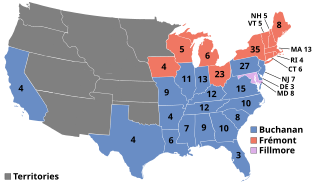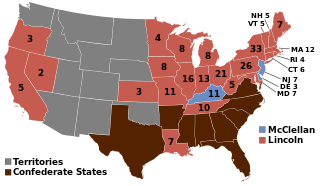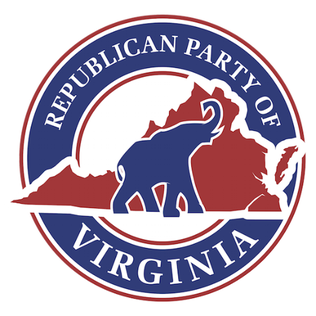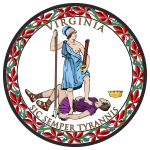
Presidential elections were held in the United States on November 2, 1852. Democratic nominee Franklin Pierce defeated Whig nominee General Winfield Scott.

Presidential elections were held in the United States on November 4, 1856. Democratic nominee James Buchanan defeated Republican nominee John C. Frémont and Know Nothing/Whig nominee Millard Fillmore. The main issue was the expansion of slavery as facilitated by the Kansas–Nebraska Act of 1854. Buchanan defeated President Franklin Pierce at the 1856 Democratic National Convention for the nomination. Pierce had become widely unpopular in the North because of his support for the pro-slavery faction in the ongoing civil war in territorial Kansas, and Buchanan, a former Secretary of State, had avoided the divisive debates over the Kansas–Nebraska Act by being in Europe as the Ambassador to the United Kingdom.

Presidential elections were held in the United States on November 6, 1860. The Republican Party ticket of Abraham Lincoln and Hannibal Hamlin won a national popular plurality, a popular majority in the North where states had already abolished slavery, and a national electoral majority comprising only Northern electoral votes. Lincoln's election thus served as the main catalyst of the states that would become the Confederacy seceding from the Union. This marked the first time that a Republican was elected president. It was also the first presidential election in which both major party candidates were registered in the same home state; the others have been in 1904, 1920, 1940, 1944, and 2016. Lincoln's 39.7% of the popular vote is to date the lowest for any winner not decided by a contingent election.

Presidential elections were held in the United States on November 8, 1864, near the end of the American Civil War. Incumbent President Abraham Lincoln of the National Union Party easily defeated the Democratic nominee, former General George B. McClellan, by a wide margin of 212–21 in the electoral college, with 55% of the popular vote. For the election, the Republican Party and some Democrats created the National Union Party, especially to attract War Democrats.

The Republican Party of Virginia (RPV) is the Virginia chapter of the Republican Party. It is based at the Richard D. Obenshain Center in Richmond. As of May 2024, it controls all three statewide elected offices, 5 out of 11 U.S. House seats, and the governor's seat within the state.

The 1856 Republican National Convention was a presidential nominating convention that met from June 17 to June 19, 1856, at Musical Fund Hall at 808 Locust Street in Philadelphia, Pennsylvania. It was the first national nominating convention of the Republican Party, founded two years earlier in 1854. It was held to nominate the party's candidates for president and vice president in the 1856 election. The convention selected John C. Frémont, a former United States Senator from California, for president, and former Senator William L. Dayton of New Jersey for vice president. The convention also appointed members of the newly established Republican National Committee.

The 1856 Whig National Convention was a presidential nominating convention held from September 17 to September 18, in Baltimore, Maryland. Attended by a rump group of Whigs who had not yet left the declining party, the 1856 convention was the last presidential nominating convention held by the Whig Party. The convention nominated a ticket consisting of former president Millard Fillmore and former ambassador Andrew J. Donelson; both had previously been nominated by the 1856 American National Convention. The Whig ticket finished third in the 1856 presidential election behind the winning Democratic ticket of James Buchanan and John C. Breckinridge and the runner-up Republican ticket of John C. Frémont and William L. Dayton.
The 1856 Democratic National Convention was a presidential nominating convention that met from June 2 to June 6 in Cincinnati, Ohio. It was held to nominate the Democratic Party's candidates for president and vice president in the 1856 election. The convention selected former Secretary of State James Buchanan of Pennsylvania for president and former Representative John C. Breckinridge of Kentucky for vice president.

John Curtiss Underwood was an attorney, abolitionist politician and a United States district judge of the United States District Court for the District of Virginia and the United States District Court for the Eastern District of Virginia.

The 1856 United States presidential election in California took place on November 4, 1856, as part of the 1856 United States presidential election. Voters chose four representatives, or electors to the Electoral College, who voted for president and vice president. California voted for the Democratic nominee, former Secretary of State James Buchanan, over the American Party nominee, former Whig President Millard Fillmore, and the Republican nominee, former U.S. Senator and Military Governor of California John C. Frémont.

The 1856 United States presidential election in Pennsylvania took place on November 4, 1856, as part of the 1856 United States presidential election. Voters chose 27 representatives, or electors to the Electoral College, who voted for president and vice president.

The 1856 United States elections elected the members of the 35th United States Congress and the President to serve from 1857 until 1861. The elections took place during a major national debate over slavery, with the issue of "Bleeding Kansas" taking center stage. Along with the 1854 elections, these elections occurred during the transitional period immediately preceding the Third Party System. Old party lines were broken; new party alignments along sectional lines were in the process of formation. The Republican Party absorbed the Northern anti-slavery representatives who had been elected in 1854 under the "Opposition Party" ticket as the second-most powerful party in Congress. Minnesota and Oregon joined the union before the next election, and elected their respective congressional delegations to the 35th Congress.

The 1860 United States presidential election in Virginia took place on November 6, 1860, as part of the 1860 United States presidential election. Voters chose 15 representatives, or electors to the Electoral College, who voted for president and vice president.

The 1859 Virginia gubernatorial election was held on May 26, 1859, to elect the governor of Virginia.

The 1856 United States presidential election in New York took place on November 4, 1856, as part of the 1856 United States presidential election. Voters chose 35 representatives, or electors to the Electoral College, who voted for president and vice president.

The 1856 United States presidential election in Florida took place on November 4, 1856, as part of the 1856 United States presidential election. Voters chose three representatives, or electors to the Electoral College, who voted for president and vice president.

The 1856 United States presidential election in North Carolina took place on November 4, 1856, as part of the 1856 United States presidential election. Voters chose 10 representatives, or electors to the Electoral College, who voted for president and vice president.

The 1856 United States presidential election in Tennessee took place on November 4, 1856, as part of the 1856 United States presidential election. Voters chose twelve representatives, or electors to the Electoral College, who voted for president and vice president.




















